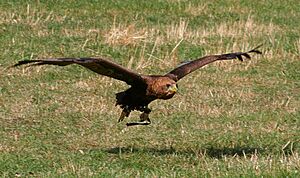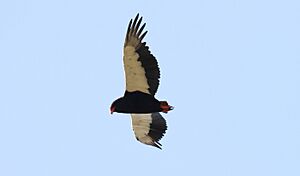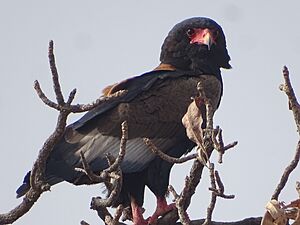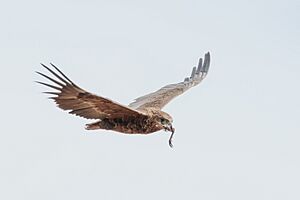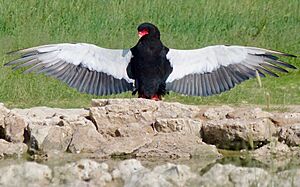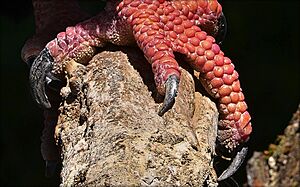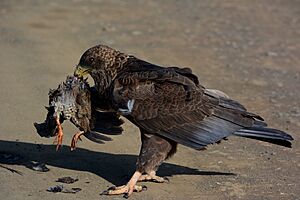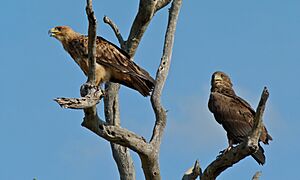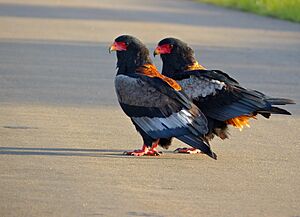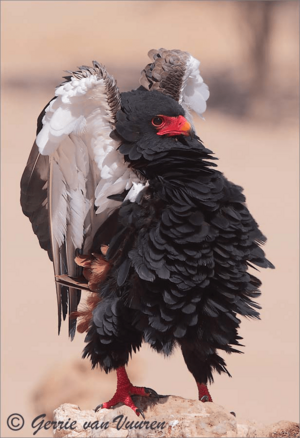Bateleur facts for kids
Quick facts for kids Bateleur |
|
|---|---|
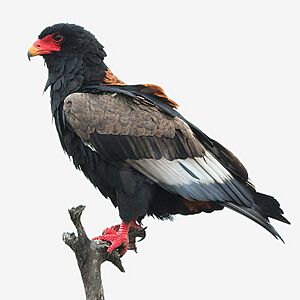 |
|
| Conservation status | |
| Scientific classification | |
| Genus: |
Terathopius
|
| Species: |
ecaudatus
|
 |
|
| approximate breeding range | |
The bateleur (also called the bateleur eagle) is a cool, medium-sized eagle. It belongs to the Accipitridae family, which includes many birds of prey. This eagle is the only member of its group, Terathopius. Some people think it might be the bird that inspired the "Zimbabwe Bird", a national symbol.
Adult bateleurs are mostly black. They have a reddish-brown color on their back and tail. Their face and feet are bright red! Young bateleurs look different. They are mostly dull brown. All bateleurs have big heads, small beaks, and very short tails. Their wings are long and curved, like a bow.
This eagle lives in many parts of Sub-Saharan Africa and a bit of Arabia. It likes open areas like savannas with some trees. Bateleurs are amazing flyers. They spend a lot of time soaring high in the sky. They eat many different things, like dead animals (carrion) and live prey. This includes small to medium-sized mammals and reptiles.
Bateleurs build strong stick nests in big trees. They usually lay only one egg. Even though they can be aggressive, they easily leave their nests if disturbed. This makes their nests easy targets for predators, including humans. It can take them 7 to 8 years to grow up fully. This is one of the longest times for any bird of prey! Sadly, the number of bateleurs is going down. They are now an Endangered species. This is mainly because of things humans do, like destroying their homes and using harmful chemicals.
Contents
What's in a Name?
The bateleur eagle is part of a group called snake eagles. Scientists have studied their genes. These studies show they are related to other snake eagles. They are even closely related to the short-toed snake eagle.
The name "Bateleur" comes from a French word. It means "street performer" or "tightrope walker". This name was given to the bird because of its amazing flying style. It often rocks from side to side in the air. The scientific name, Terathopius ecaudatus, also has a meaning. Teras is Greek for "marvelous". Ops is Greek for "face". E is Latin for "without". Caudatus is Latin for "tail". So, it means "marvelous-faced, without a tail"!
Meet the Bateleur Eagle
The bateleur looks very special. It has a thick neck and a big head. Its beak is small but has a large, bright red cere (the waxy part above the beak). Its legs are short, and its tail is super short. In fact, it might have the shortest tail of all birds of prey! When it sits, it stands very straight. This makes it look tall, even with its short legs.
Its wings are huge. They have many flight feathers, maybe more than any other bird of prey. Adult bateleurs have reddish-brown on their back and tail. Most of their body is black. Males have gray shoulders. Females have more gray-brown on their wings.
Some bateleurs have a "cream morph". This means their reddish-brown parts are creamy or pale brown instead. The bright red parts on their face and feet can sometimes turn pink or yellowish. This happens when they are in the shade or bathing. These parts get very red when the bird is excited!
Young bateleurs look quite different from adults. They have longer tails. Their feathers are mostly brown. Their head is lighter brown. Their eyes are brown. The cere (above the beak) is greenish-blue, and their feet are whitish. It takes many years for them to get their adult colors. By 5 years old, their cere and feet turn yellow, then pink, then red. By 8 years old, they finally look like adults.
Flying High
In the air, the bateleur looks like a large bird with long, narrow, curved wings. Its tail is so short that its feet stick out past it! This makes it look like it has almost no tail. Young bateleurs have longer tails, so their feet don't stick out as much. An adult bateleur's wingspan is almost three times its body length.
Males are mostly black with a reddish-brown back and tail. Their front wings are gray. Females are similar but have more white under their wings. Young bateleurs are all brown in flight. They have broader wings and a longer tail than adults.
How Big Are They?
The bateleur is a medium-sized eagle. It is one of the heaviest snake eagles. It can be from 55 to 70 cm (22 to 28 inches) long. A typical adult is about 63.5 cm (25 inches) long. Their wingspan can be from 168 to 190 cm (5.5 to 6.2 feet). They usually weigh between 1.8 to 3 kg (4 to 6.6 pounds). Females are a little bigger than males, but not by much.
Bateleurs have strong feet with thick skin and short, sharp talons. Their toes are large, almost like an owl's. They have a big head but a small beak. These features help them catch and eat snakes.
What Do They Sound Like?
Bateleurs are usually quiet. But they do make calls, especially when flying or displaying. Their main call is a loud, harsh schaaaa-aw. They also make barking calls, like kow-aw. Sometimes, they make softer calls near their nest. Young bateleurs make squealing sounds, like kyup-kyup keeaw keeaw, when they are hungry.
Where Bateleurs Live
Bateleurs live in a huge area across Africa, south of the Sahara Desert. They are also found in parts of Saudi Arabia and Yemen. They like open savannas and woodlands with trees. They don't usually live in thick forests or high mountains. They also avoid very dry deserts or large wetlands.
They need trees for nesting. In Kenya, they are not found where there is very little rain. This is probably because not enough trees can grow there. They can live from sea level up to 4,500 meters (14,800 feet) high. But they usually stay below 3,000 meters (9,800 feet).
Bateleur Behavior
Bateleurs are easy to spot because they fly so much. They spend most of their day soaring low over their habitat. They take off with quick, shallow wing beats. Then they glide at about 50 to 60 km/h (30 to 37 mph). They often rock side-to-side while flying. This is why they are called "bateleurs" (street performers). They can also do a quick 360-degree roll in the air! They often do these fancy moves when another bateleur is nearby.
Bateleurs usually live alone. But young birds might stay with their parents for a few months. Sometimes, many young bateleurs gather in one place. This happens when there's a lot of food, like a big dead animal or after a bush fire.
In the wild, bateleurs are shy of people. They can easily leave their nest if disturbed. But in zoos, they can become very tame.
Staying Cool and Warm
Bateleurs spend a lot of time warming up in the sun or cooling off by bathing. They often go into water to bathe. Then they spread their wings to dry and sunbathe. They stand upright with their wings spread out. This is called a "phoenix pose". They turn to follow the sun. This helps them warm the oils in their feathers. Then they spread the oils with their beak. This makes their feathers better for flying.
Sometimes, bateleurs let ants crawl on their wings. This is called "anting". The ants secrete a special acid that kills ticks and fleas on the bird. This helps the bateleur get rid of parasites.
What Bateleurs Eat
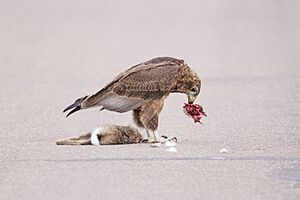
Bateleurs eat many different things. They usually hunt while flying low. They look for food on the ground. When they spot something, they spiral down to check it out. They are very good at finding dead animals (carrion). They are often the first birds to arrive at large carcasses. Young bateleurs eat more carrion than adults.
Even though they scavenge, bateleurs are also strong hunters. They kill most of their prey on the ground. They dive down with their wings partly closed. They can also catch birds in the air. Sometimes, they steal food from other birds of prey. They might even fight larger eagles or vultures for food!
Bateleurs eat about 160 different kinds of prey. This makes them one of the most varied eaters among African eagles. They mostly eat mammals, birds, and reptiles. About half of their diet comes from mammals. A quarter comes from birds, and about 18% from reptiles. They also eat a small amount of fish and insects.
Mammal Meals
Bateleurs eat many types of mammals. They hunt small animals like rodents and shrews. They also go for larger rodents like Gambian pouched rats. They eat different kinds of hares. They can even kill mammals heavier than themselves! For example, they have been known to kill hares, Cape hyraxes, and Kirk's dik-diks. These animals can weigh more than the eagle itself.
They also scavenge on larger dead animals. This includes antelopes and even lions.
Bird Bites
Bateleurs eat many different birds, about 80 species. They often hunt smaller birds. They especially like pigeons and doves. They also eat nightjars, shorebirds, kingfishers, and starlings. The biggest birds they hunt are usually gamebirds like guineafowl and francolin. These can weigh up to 1.8 kg (4 pounds).
Reptile Rations
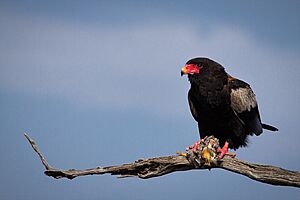
Bateleurs also eat reptiles, especially snakes. They can catch small, harmless snakes. But they are also brave enough to take on venomous snakes like puff adders and Egyptian cobras. They can even eat large snakes like mambas. However, they are not immune to snake venom. Sometimes, both the snake and the eagle die in a fight.
They also eat monitor lizards and small tortoises. They might eat these after they are already dead, like from road accidents.
Who Else Lives There?
Bateleurs live in Africa with many other birds of prey. They compete for food. The tawny eagle is very similar to the bateleur. They are about the same size and hunt in similar ways. Both can hunt live prey, scavenge, and steal food.
Tawny eagles are usually stronger than bateleurs at food sites. Bateleurs often wait until the tawny eagle finishes eating. But bateleurs are better at finding food first. They can fly for a long time to find carcasses.
Bateleurs are usually at the bottom of the pecking order when it comes to scavenging. Spotted hyenas are at the top, then vultures, then tawny eagles, and then bateleurs. But because vultures are disappearing in Africa, bateleurs and tawny eagles are seen more often. This is because there is less competition for food.
Sometimes, bateleurs even attack and scare away much larger vultures! They have also been seen fighting with powerful martial eagles.
Bateleurs sometimes hunt other birds of prey. They have been seen eating black-winged kites, barn owls, and even large Verreaux's eagle owls. Adult bateleurs are usually top predators. But their young are very vulnerable. This is because the parents often leave the nest to hunt for long periods. So, many predators might attack the chicks.
Life Cycle and Reproduction
Bateleurs live a long time. They grow up slowly and don't breed very often. They have a "spectacular" courtship display. The male dives at the female, and she rolls to show him her claws. He might also fly with his legs dangling. This makes a loud whup-whup-whup sound.
Bateleurs usually mate for life. They are monogamous. Their breeding season can vary depending on where they live. In East Africa, it can be almost any month. In Southern Africa, it's usually from December to August.
Nests and Eggs
Bateleurs build their nests in large trees. The nests are usually 10 to 15 meters (33 to 49 feet) high. They are often in the fork of a main branch, shaded from the sun. They use different types of trees, especially Acacia trees. The nest is a strong structure made of sticks. It's about 60 cm (2 feet) wide and 30 cm (1 foot) deep. They line the nest with green leaves.
Bateleurs only lay one egg. The egg is quite large for the bird's size. It's usually white, sometimes with a few reddish marks. The female usually sits on the egg alone. The male brings her food. The egg takes about 52 to 59 days to hatch. This is one of the longest incubation times for an African bird of prey.
Growing Up
When the chick hatches, it is very weak. It's covered in creamy down feathers. At first, it can't even lift its head. As it grows, its feathers start to appear. By 7 weeks, most of its body is feathered. The young bateleur looks like a young snake eagle.
The chick can stand at about 5 weeks old. It starts feeding itself around 6 weeks. It takes its first flight between 90 and 125 days (about 3 to 4 months). After its first flight, it often returns to the nest. Young bateleurs become independent quickly, usually within 2 to 4 months. They often fly around with their parents until they can find food on their own.
Parenting Style
When someone comes near the nest, bateleurs might bark loudly or dive at the intruder. But they often fly away and don't return for hours. They are more likely to leave their young than almost any other African eagle. The male is usually more protective at the nest. He might dive-bomb intruders.
Bateleur parents are very sensitive to human disturbance. Even small things, like hiding a camera nearby, can make them leave the nest. This leads to many nests failing. The female takes care of the chick a lot when it's very young. But as it gets older, she spends less time at the nest. Both parents bring food to the young.
Conservation Efforts
Bateleurs are found in many places, but their numbers are going down fast. In the 1990s, there were thought to be about 180,000 bateleurs. Now, the IUCN estimates there are only 10,000 to 100,000 left. The biggest drops in numbers have been in Southern Africa. In some areas, their population has gone down by 75%.
Bateleurs are now considered threatened in countries like Zimbabwe, Namibia, and South Africa. They are also declining in many other African countries. They are much more common in protected areas like national parks. But even in some parks, their numbers are still decreasing.
The main reasons for their decline are human activities. These include:
- Habitat destruction: People are building more homes and farms. This takes away the bateleurs' natural living spaces.
- Poisoning: Farmers sometimes use poisons to kill animals like jackals. Poachers also use poisons to kill vultures, so they can hide illegal wildlife killings. Bateleurs eat dead animals, so they often get poisoned too.
- Hunting: Some people shoot or trap bateleurs. Their feathers are sometimes used in traditional medicine.
- Disturbance: People disturbing their nests causes parents to abandon their young.
There are no big plans to save them yet. But some countries are trying to protect them. People are also trying to teach others about the dangers of poisoned baits. Scientists are also watching their populations.
Cultural Importance
The bateleur eagle is important in African cultures. It's known for its beautiful colors and bold behavior. Many people believe the bateleur is the bird behind the "Zimbabwe Bird". This symbol has been used in Zimbabwe for a long time. It's even on the country's flag!
In South Africa, there's a myth that when a bateleur cries in flight, it will rain. In other parts of Africa, the bateleur is seen as a smart helper to its masters, who were thought to be vultures.
Images for kids
-
Skeleton of a bateleur eagle (Museum of Osteology)




